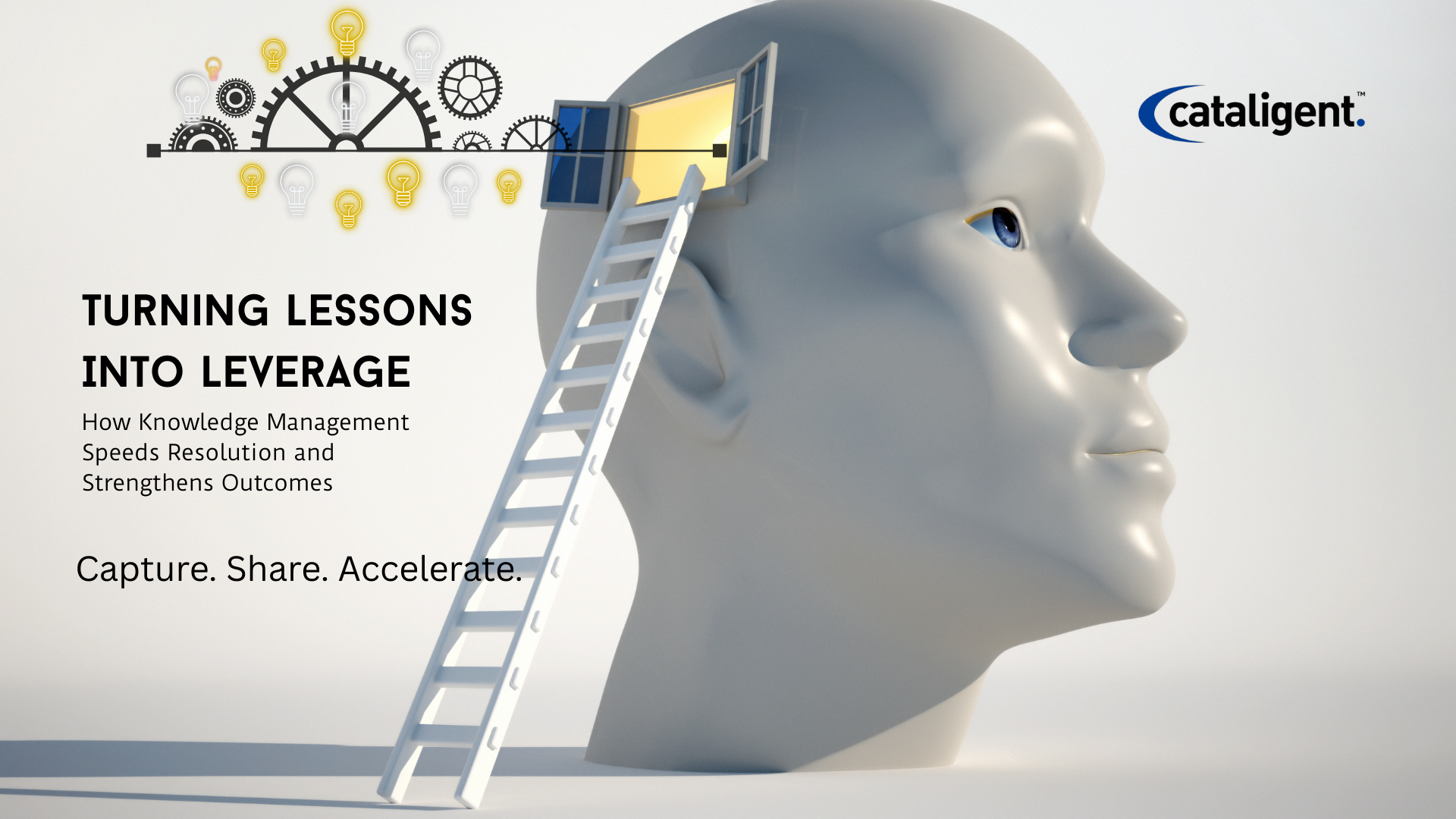What is Knowledge Management?
Knowledge Management (KM) within IT Service Management (ITSM) is a systematic process for capturing, organizing, sharing, and leveraging information gained from IT operations and service management activities. It focuses on turning raw operational data, solutions, lessons learned, and best practices into structured knowledge that can be applied to enhance decision-making, streamline operations, and improve service delivery. KM ensures that valuable organizational knowledge is retained, easily accessible, and actionable.
Cataligent assists organizations in implementing comprehensive KM frameworks that centralize knowledge, enable reuse, improve collaboration, and increase operational efficiency.
Why Knowledge Management is Critical
Effective KM is fundamental for increasing IT efficiency, service quality, and organizational resilience:
- Faster Incident Resolution: Access to comprehensive documentation, historical data, and troubleshooting guides allows IT teams to quickly diagnose and resolve issues, reducing downtime and maintaining business continuity.
- Consistency and Standardization: KM ensures IT staff follow established best practices and standardized procedures, reducing errors, ensuring service reliability, and maintaining a consistent user experience.
- Reduced Dependency on Key Personnel: By capturing knowledge in systems rather than relying on individuals, organizations mitigate risks associated with staff turnover or absence. Critical expertise is preserved and accessible across teams.
- Proactive Problem Prevention: Historical insights and trend analysis enable IT teams to identify recurring issues, potential system vulnerabilities, and emerging risks, allowing preventive measures before incidents occur.
- Enhanced Collaboration: Centralized knowledge fosters cross-functional learning and collaboration, enabling IT teams to share expertise, innovate, and solve complex problems collectively.
- Operational Efficiency and Cost Savings: Rapid access to actionable knowledge reduces redundant work, minimizes repetitive investigations, and optimizes resource allocation, leading to significant time and cost savings.
Organizations without effective KM experience slower resolution times, inconsistent services, repeated mistakes, and lost organizational intelligence.
How Knowledge Management Shapes Cost Saving and Efficiency
Structured KM directly impacts operational performance, efficiency, and cost-effectiveness:
- Centralized Knowledge Repositories:
Cataligent helps organizations build centralized, searchable knowledge bases containing resolution guides, troubleshooting steps, and lessons learned. This ensures IT staff can quickly access critical information, reducing time spent on problem-solving and accelerating service restoration. Centralized repositories also allow organizations to systematically manage and update knowledge over time. - Categorization and Indexing:
Proper categorization, tagging, and indexing make knowledge easily retrievable. Cataligent implements advanced organizational structures that ensure relevant information is available when needed, enhancing response times and reducing the frustration of searching for solutions across disparate sources. Effective indexing ensures that knowledge is not only stored but also actively usable. - Integration with Incident and Problem Management:
KM is integrated with incident, problem, and service request management, allowing historical data to inform current operations. Cataligent ensures that IT teams can leverage resolutions to prevent issue recurrence, enhance troubleshooting efficiency, and proactively manage potential problems. This integration transforms KM from a static repository into a dynamic tool that directly improves operational performance. - Automated Knowledge Capture:
During incident resolution, preventive actions, and problem-solving, lessons learned and procedural steps are automatically recorded into the knowledge base. Cataligent provides automation tools to capture this knowledge in real-time, reducing manual effort and ensuring that valuable insights are not lost. Automation enhances completeness, accuracy, and usability of the knowledge repository. - Self-Service Portals:
End-users gain access to knowledge articles, FAQs, and guides through intuitive self-service platforms. Cataligent designs portals that empower users to resolve common issues independently, reducing the number of service requests, freeing IT resources for higher-value work, and increasing overall satisfaction. Self-service also promotes user engagement and educates employees on standard procedures. - Continuous Knowledge Improvement:
Knowledge is continuously reviewed, validated, and updated to maintain accuracy, relevance, and quality. Cataligent implements governance frameworks, feedback loops, and quality control processes that ensure knowledge remains actionable and effective. Continuous improvement ensures that KM evolves with organizational needs, technological changes, and emerging business priorities.
How Cataligent Can Help
Cataligent provides end-to-end KM solutions:
- Knowledge Base Design and Implementation: Creates centralized, structured, and easily searchable repositories for IT knowledge, facilitating quick access and application.
- Integration with ITSM Processes: Ensures that KM is seamlessly linked with incident, problem, and service request management, enabling informed decision-making and preventive actions.
- Automated Capture and Updating: Records solutions, lessons, and preventive measures automatically, ensuring continuous growth and relevance of knowledge.
- Self-Service Portals: Develops intuitive platforms that empower end-users to access and apply knowledge independently, reducing support workload.
- Governance and Quality Control: Maintains the accuracy, relevance, and compliance of knowledge content through structured review and validation processes.
- Analytics and Reporting: Provides insights into knowledge utilization, gaps, and impact on resolution times, allowing organizations to optimize knowledge management strategies and operational efficiency.
Embedded Value for Organizations
- Reduced Resolution Times: Faster access to actionable information accelerates incident resolution, minimizing downtime and operational impact.
- Operational Efficiency: Streamlines processes, reduces redundant efforts, and optimizes resource utilization, improving IT service delivery.
- Knowledge Retention: Preserves organizational intelligence and reduces dependency on specific personnel, mitigating operational risks.
- Consistency in Service Delivery: Standardized procedures and best practices ensure predictable, high-quality IT services.
- Proactive Issue Prevention: Trend analysis and historical data allow IT teams to anticipate and mitigate recurring problems.
- Empowered Users: Self-service capabilities enhance user satisfaction while reducing support demand.
- Continuous Improvement: Ongoing validation and updates ensure knowledge remains accurate, relevant, and actionable.
- Strategic Decision Support: Knowledge insights inform IT planning, resource allocation, and business strategy alignment.
Knowledge Management transforms IT service delivery by capturing, organizing, and reusing organizational lessons and information. Cataligent provides the tools, frameworks, and governance necessary to reduce resolution times, enhance efficiency, ensure consistency, and achieve sustainable cost savings while supporting strategic IT objectives.

